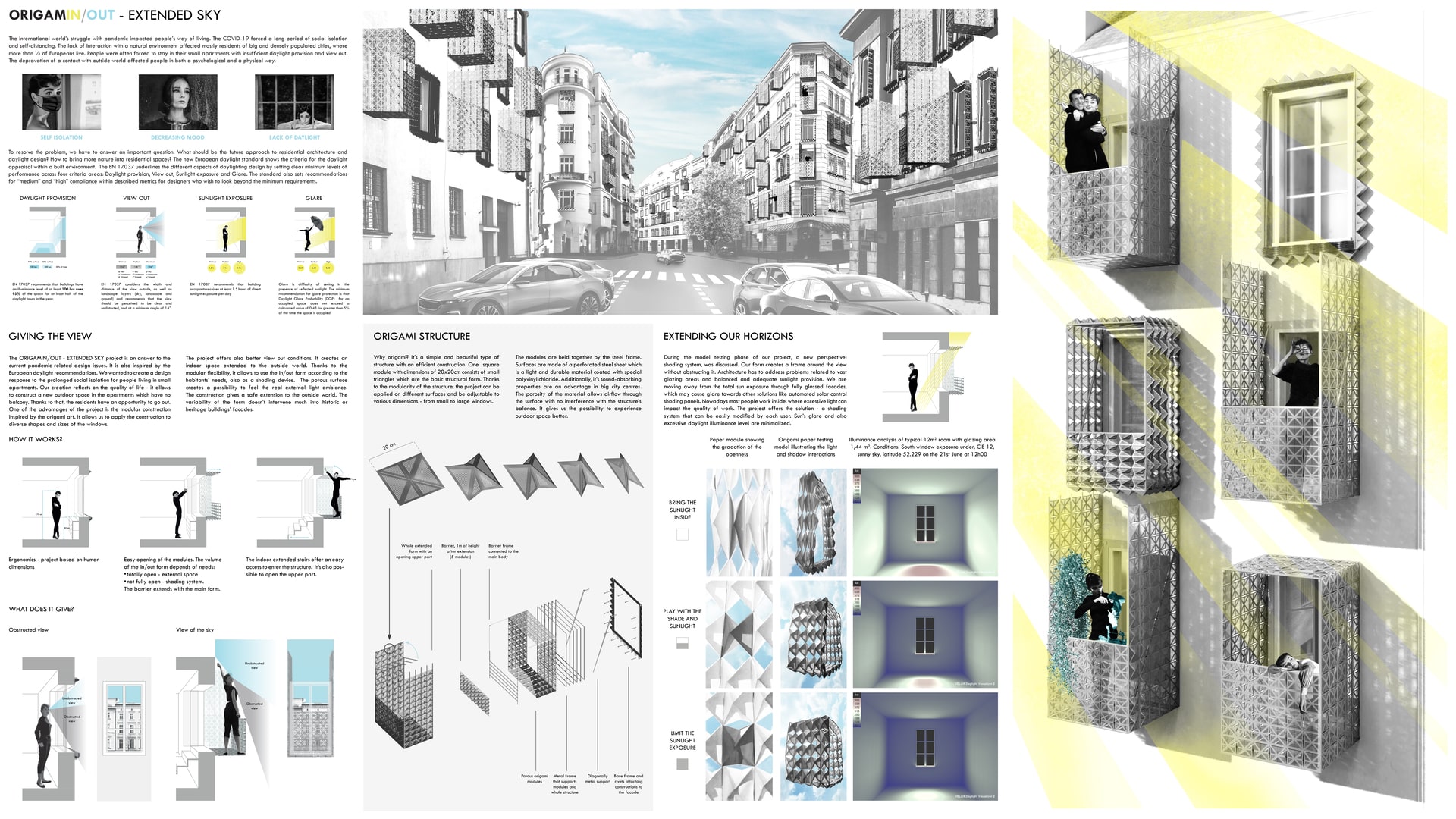Project Description
ORIGAMIN/OUT - EXTENDED SKY The international world’s struggle with pandemic impacted people’s way of living. The COVID-19 forced a long period of social isolation and self-distancing. The lack of interaction with a natural environment affected mostly residents of big and densely populated cities, where more than ¼ of Europeans live. People were often forced to stay in their small apartments with insufficient daylight provision and view out. The depravation of a contact with outside world affected people in both a psychological and a physical way. To resolve the problem, we have to answer an important question: What should be the future approach to residential architecture and daylight design? How to bring more nature into residential spaces? The new European daylight standard shows the criteria for the daylight appraisal within a built environment. The EN 17037 underlines the different aspects of daylighting design by setting clear minimum levels of performance across four criteria areas: Daylight provision, View out, Sunlight exposure and Glare. The standard also sets recommendations for “medium” and “high” compliance within described metrics for designers who wish to look beyond the minimum requirements. GIVING THE VIEW The ORIGAMIN/OUT - EXTENDED SKY project is an answer to the current pandemic related design issues. It is also inspired by the European daylight recommendations. We wanted to create a design response to the prolonged social isolation for people living in small apartments. Our creation reflects on the quality of life - it allows to construct a new outdoor space in the apartments which have no balcony. Thanks to that, the residents have an opportunity to go out. One of the advantages of the project is the modular construction inspired by the origami art. It allows us to apply the construction to diverse shapes and sizes of the windows. The project offers also better view out conditions. It creates an indoor space extended to the outside world. Thanks to the modular flexibility, it allows to use the in/out form according to the habitants’ needs, also as a shading device. The porous surface creates a possibility to feel the real external light ambiance. The construction gives a safe extension to the outside world. The variability of the form doesn’t intervene much into historic or heritage buildings’ facades. ORIGAMI STRUCTURE Why origami? It’s a simple and beautiful type of structure with an efficient construction. One square module with dimensions of 20x20cm consists of small triangles which are the basic structural form. Thanks to the modularity of the structure, the project can be applied on different surfaces and be adjustable to various dimensions - from small to large windows. The modules are held together by the steel frame. Surfaces are made of a perforated steel sheet which is a light and durable material coated with special polyvinyl chloride. Additionally, it’s sound-absorbing properties are an advantage in big city centres. The porosity of the material allows airflow through the surface with no interference with the structure’s balance. It gives us the possibility to experience outdoor space better. EXTENDING OUR HORIZONS During the model testing phase of our project, a new perspective: shading system, was discussed. Our form creates a frame around the view without obstructing it. Architecture has to address problems related to vast glazing areas and balanced and adequate sunlight provision. We are moving away from the total sun exposure through fully glassed facades, which may cause glare towards other solutions like automated solar control shading panels. Nowadays most people work inside, where excessive light can impact the quality of work. The project offers the solution - a shading system that can be easily modified by each user. Sun’s glare and also excessive daylight illuminance level are minimalized.
